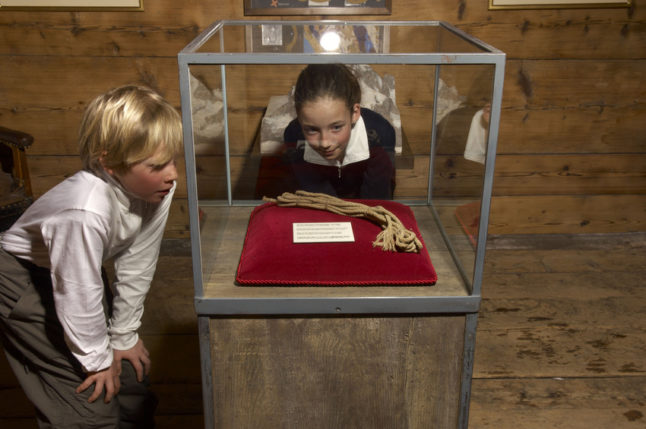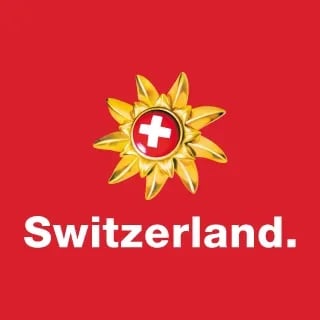From stuffed frogs, to the world’s biggest foosball table, via a creepy alien interior, we’ve put together a list of eight entirely unique museums across Switzerland that you should visit this year.
Hoosesagg Museum, Basel
Let’s start small—really small. The ‘Hoosesagg Museum‘ (Pants Pocket Museum) is a two-foot-by-two-foot window on Imbergässlein, a short stroll from the marketplace.
The Vergeats, the owners of the historic home it is housed, became fed up with passersby peering in, so they began exhibiting tiny objects. Soon, others contacted the Vergeats, wanting to display their collections of shot glasses, thimbles and other minuscule treasures.
The window first became a viral sensation before transforming into a fully-fledged museum of objects that can fit in a trouser pocket.
Exhibits change frequently, and it’s one of the city’s most photographed locations.
The smallest museum in the world? It's just this one window! Read more here: https://t.co/kSTbfXK6yE#sponsored @baseltourism #thisisbasel #basel #switzerland #hoosesagg pic.twitter.com/Vazq1gP8Uh
— Rachel Heller (@rachelruminates) September 10, 2021
Museum HR Giger, Gruyères, Freiburg
The ‘Alien’ films have traumatised audiences for over thirty years, mostly due to the horrific biomechanical art of Swiss Artist H. R. Giger.
Giger both designed and constructed the museum dedicated to his art in the beautiful medieval city of Gruyères. Therefore, you won’t be amidst a bright, sterile environment.
Instead, expect to feel like you’ve stepped into the lair of the ‘space jockey’ from Ridley Scott’s 1979 classic – walls, doorways and furniture appearing as if they’ve been grown rather than built.
Afterwards, calm your nerves with a drink in the museum’s bar, even if it does carry the theme over. Maybe not the location for a first date!
H.R. Giger museum based in Switzerland pic.twitter.com/fI6j7Lpofe
— Xeo ¯³ (@xe0_xeo) March 26, 2024
Frog Museum, Estavayer-le-Lac, Freiburg
Everybody needs a hobby, right? For one nineteenth-century Swiss military officer, his was catching frogs and taxidermied them, posing them in weird, beautiful dioramas that poked funny at everyday life.
The museum in the small town of Estavayer-le-Lac, on the shores of Lake Neuchâtel, acquired his collection sometime around 1927. Around 150 of the officer’s unique creations are now on display, alongside artefacts that help tell the region’s story.
Frogs are arranged in a dining scene at the Frog Museum, a collection of 108 stuffed frogs in scenes portraying everyday life in the 19th century and made by Francois Perrier, in Estavayer-le-Lac, Switzerland pic.twitter.com/9N8s5eyUwY
— Boateng Duka Kofi (@DukaKofi) November 12, 2018
Matterhorn Museum, Zermatt, Valais
The Matterhorn occupies a unique position in the popular imagination—a towering mountain that sums up much about Switzerland. Of course, it has its own museum, located in the town of Zermatt, which lies at its base.
Particularly moving are the exhibits dedicated to the first ascent of the Matterhorn in 1865, which claimed four of the seven climbers involved – the centrepiece being the broken climbing rope.
Another equally poignant story is told by the remains of ‘Theo’, a sixteenth-century mercenary who perished crossing the Theodul Pass. only to be released by the glacier hundreds of years later.
Matterhorn museum! pic.twitter.com/2cJok8tuVj
— David BRUTON JR. PT, DPT (@D_Brut30) March 13, 2014
Schloss Habsburg, Habsburg, Aargau
Looking at it, you wouldn’t think this squat little castle was the seat of Europe’s greatest dynasty. Yet the clue is in the name.
In Schloss Habsburg, close to the border with Germany, the family who would come to rule almost half the world for a thousand years first emerged.
To learn how an unassuming family of minor nobles came to take the reigns of imperial power, a permanent exhibition in the castle serves as a fantastic, concise introduction.
One particular highlight is the virtual reality reconstruction of the castle. Not only can you explore the interior, but you can also take flight, to take in all the details you can’t see from ground level.
So haben Sie Schloss Habsburg noch nie gesehen!
Das Museum Aargau zeigt neu mit Virtual-Reality-Technologie die ganze Pracht der Habsburg um das Jahr 1200. Jetzt das Schloss besuchen, dort VR-Brille aufsetzen – und los geht der abenteuerliche Rundflug über die Burg! pic.twitter.com/nvHckJWCyD— Museum Aargau (@museumaargau) October 1, 2019
Forum of Swiss History
Hofmatt, Schwyz
Switzerland’s political entity is unique in the world—twenty-six cantons with unprecedented levels of devolved power. How did it get that way?
That’s the question that the Forum of Swiss History in Hofmatt seeks to answer.
Over three floors of a historic building, the story of Switzerland from the twelfth to fourteenth centuries is told – a dangerous, lawless alpine realm coalescing into a powerful confederation that no other power managed to conquer.
A particular highlight of this museum is the dioramas and recreations of historical locations, such as monasteries, that can be found throughout.
Learning about the birth of Swiss Confederation in the heart of #schwyz at the Forum of Swiss History. @CanSwitzerland pic.twitter.com/XtK2xKSwFu
— Susan Bincoletto (@SusanBincoletto) April 1, 2018
FIFA Museum, Zurich
Love or loathe them as an entity, there’s no denying that FIFA’s history is the history of international football. Therefore, visiting the FIFA Museum in Zurich is essential for every fan.
Across almost three thousand square metres, not only can you understand how the organisation has shaped football worldwide but also better understand the football countries of over 211 countries that have competed over the years—some of which no longer exist.
If you bring the kids, you can participate in the world’s largest foosball table!
The official current World Cup trophy on display in Zurich's wonderful FIFA Museum 🏆⚽️🇨🇭#Switzerland pic.twitter.com/eKZwAhrLc1
— Ben Warren 🏏 (@BenWarrenSCCC) November 12, 2023
Swiss Witchcraft Museum, Gränichen, Aargau
Our last museum is again small but receives rave reviews. In Schloss Liebegg, located in the Aargau village of Gränichen, the Swiss Witchcraft Museum dedicates itself to the traditional folk beliefs of cultures worldwide.
The museum also explains how women have been persecuted over the centuries within Switzerland itself – a particular nexus of hysteria related to witchcraft.
This museum is an idiosyncratic labour of love and doesn’t even have consistent opening hours. It’s therefore essential to check whether it’ll be open in advance.
Today I visited the #Witchcraft museum #HexenMuseum @hexenmuseum located in a beautiful 11th century castle sitting atop a steep hill in the Swiss countryside.
The location is gorgeous, the castle is beautiful and well kept, the exhibits are interesting… https://t.co/uDPqx755To pic.twitter.com/GdiqUhG8BH
— Marc Urselli (@MarcUrselli) March 16, 2023
Can you suggest an amazing Swiss museum we should know about? Let us know in the comments!




 Please whitelist us to continue reading.
Please whitelist us to continue reading.
Not to forget the military museum next to then Château de Chillon, near Montreux.